Book contents
- Frontmatter
- Contents
- List of abbreviations
- Foreword
- Acknowledgements
- Introduction
- 1 The problem of child labour
- 2 The prohibition of child labour in international law
- 3 UN and ILO implementation mechanisms for the prohibition of child labour
- 4 Trade measures on child labour
- 5 Recommendations for an ILO–WTO enforcement regime
- Concluding summary
- Bibliography
- Index
- CAMBRIDGE STUDIES IN INTERNATIONAL AND COMPARATIVE LAW
2 - The prohibition of child labour in international law
Published online by Cambridge University Press: 20 February 2010
- Frontmatter
- Contents
- List of abbreviations
- Foreword
- Acknowledgements
- Introduction
- 1 The problem of child labour
- 2 The prohibition of child labour in international law
- 3 UN and ILO implementation mechanisms for the prohibition of child labour
- 4 Trade measures on child labour
- 5 Recommendations for an ILO–WTO enforcement regime
- Concluding summary
- Bibliography
- Index
- CAMBRIDGE STUDIES IN INTERNATIONAL AND COMPARATIVE LAW
Summary
INTRODUCTION
Since international legislation provides the basis and framework for international and national preventive measures and punitive action, the content and scope of international child labour standards will be analysed first. The following section examines which international treaty norms prohibit exploitative child labour as defined by the ILO and UNICEF, and what state obligations they impose. This includes the question of to what extent states are responsible in relation to private parties. Additionally, the question arises whether the prohibition of exploitative child labour forms part of customary law or can be classified as ius cogens.
It should be noted that conventions are binding for states parties that have ratified the relevant convention. By contrast, declarations and recommendations are not legally binding but may constitute important supplements and clarifications concerning conventions. As so-called ‘soft law’, recommendations can be relevant with regard to the process of the formation of customary or treaty law.
UN CONVENTIONS AND PROTOCOLS AND THE UNIVERSAL DECLARATION OF HUMAN RIGHTS
The Slavery Convention
The Slavery Convention of 1926 was adopted under the auspices of the League of Nations and can be called the first modern international treaty for the protection of human rights. In 1991, eighty-six states had ratified the Convention.
Wording
Art. 1 (1) of the Slavery Convention defines slavery as:
The status or condition of a person over whom any or all of the powers attaching to the right of ownership are exercised.
- Type
- Chapter
- Information
- The Challenge of Child Labour in International Law , pp. 35 - 121Publisher: Cambridge University PressPrint publication year: 2009



